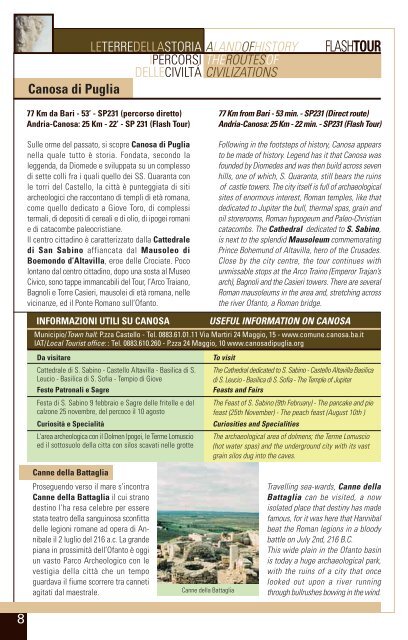FlashTour Le terre della Storia - Puglia
FlashTour Le terre della Storia - Puglia
FlashTour Le terre della Storia - Puglia
Create successful ePaper yourself
Turn your PDF publications into a flip-book with our unique Google optimized e-Paper software.
LETERREDELLASTORIA ALANDOFHISTORY<br />
IPERCORSI THEROUTESOF<br />
DELLECIVILTÁ CIVILIZATIONS<br />
Canosa di <strong>Puglia</strong><br />
FLASHTOUR<br />
77 Km da Bari - 53’ - SP231 (percorso diretto)<br />
Andria-Canosa: 25 Km - 22’ - SP 231 (Flash Tour)<br />
Sulle orme del passato, si scopre Canosa di <strong>Puglia</strong><br />
nella quale tutto è storia. Fondata, secondo la<br />
leggenda, da Diomede e sviluppata su un complesso<br />
di sette colli fra i quali quello dei SS. Quaranta con<br />
le torri del Castello, la città è punteggiata di siti<br />
archeologici che raccontano di templi di età romana,<br />
come quello dedicato a Giove Toro, di complessi<br />
termali, di depositi di cereali e di olio, di ipogei romani<br />
e di catacombe paleocristiane.<br />
Il centro cittadino è caratterizzato dalla Cattedrale<br />
di San Sabino affiancata dal Mausoleo di<br />
Boemondo d’Altavilla, eroe delle Crociate. Poco<br />
lontano dal centro cittadino, dopo una sosta al Museo<br />
Civico, sono tappe immancabili del Tour, l’Arco Traiano,<br />
Bagnoli e Torre Casieri, mausolei di età romana, nelle<br />
vicinanze, ed il Ponte Romano sull’Ofanto.<br />
77 Km from Bari - 53 min. - SP231 (Direct route)<br />
Andria-Canosa: 25 Km - 22 min. - SP231 (Flash Tour)<br />
Following in the footsteps of history, Canosa appears<br />
to be made of history. <strong>Le</strong>gend has it that Canosa was<br />
founded by Diomedes and was then build across seven<br />
hills, one of which, S. Quaranta, still bears the ruins<br />
of castle towers. The city itself is full of archaeological<br />
sites of enormous interest, Roman temples, like that<br />
dedicated to Jupiter the bull, thermal spas, grain and<br />
oil storerooms, Roman hypogeum and Paleo-Christian<br />
catacombs. The Cathedral dedicated to S. Sabino,<br />
is next to the splendid Mausoleum commemorating<br />
Prince Bohemund of Altavilla, hero of the Crusades.<br />
Close by the city centre, the tour continues with<br />
unmissable stops at the Arco Traino (Emperor Trajan’s<br />
arch), Bagnoli and the Casieri towers. There are several<br />
Roman mausoleums in the area and, stretching across<br />
the river Ofanto, a Roman bridge.<br />
INFORMAZIONI UTILI SU CANOSA USEFUL INFORMATION ON CANOSA<br />
Municipio/Town hall: P.zza Castello - Tel. 0883.61.01.11 Via Martiri 24 Maggio, 15 - www.comune.canosa.ba.it<br />
IAT/Local Tourist office: : Tel. 0883.610.260 - P.zza 24 Maggio, 10 www.canosadipuglia.org<br />
Da visitare<br />
Cattedrale di S. Sabino - Castello Altavilla - Basilica di S.<br />
<strong>Le</strong>ucio - Basilica di S. Sofia - Tempio di Giove<br />
Feste Patronali e Sagre<br />
Festa di S. Sabino 9 febbraio e Sagre delle fritelle e del<br />
calzone 25 novembre, del percoco il 10 agosto<br />
Curiosità e Specialità<br />
L'area archeologica con il Dolmen Ipogei, le Terme Lomuscio<br />
ed il sottosuolo <strong>della</strong> citta con silos scavati nelle grotte<br />
To visit<br />
The Cathedral dedicated to S. Sabino - Castello Altavilla Basilica<br />
di S. <strong>Le</strong>ucio - Basilica di S. Sofia - The Temple of Jupiter<br />
Feasts and Fairs<br />
The Feast of S. Sabino (9th February) - The pancake and pie<br />
feast (25th November) - The peach feast (August 10th )<br />
Curiosities and Specialities<br />
The archaeological area of dolmens; the Terme Lomuscio<br />
(hot water spas) and the underground city with its vast<br />
grain silos dug into the caves.<br />
Canne <strong>della</strong> Battaglia<br />
Proseguendo verso il mare s’incontra<br />
Canne <strong>della</strong> Battaglia il cui strano<br />
destino l’ha resa celebre per essere<br />
stata teatro <strong>della</strong> sanguinosa sconfitta<br />
delle legioni romane ad opera di Annibale<br />
il 2 luglio del 216 a.c. La grande<br />
piana in prossimità dell’Ofanto è oggi<br />
un vasto Parco Archeologico con le<br />
vestigia <strong>della</strong> città che un tempo<br />
guardava il fiume scorrere tra canneti<br />
agitati dal maestrale.<br />
Canne <strong>della</strong> Battaglia<br />
Travelling sea-wards, Canne <strong>della</strong><br />
Battaglia can be visited, a now<br />
isolated place that destiny has made<br />
famous, for it was here that Hannibal<br />
beat the Roman legions in a bloody<br />
battle on July 2nd, 216 B.C.<br />
This wide plain in the Ofanto basin<br />
is today a huge archaeological park,<br />
with the ruins of a city that once<br />
looked out upon a river running<br />
through bullrushes bowing in the wind.<br />
8

















